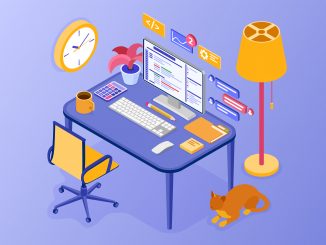
In the new post-COVID-19 normal when some many companies enabled much of their workforce to work remotely, or work from home, I thought I’d share some tricks from my IT toolbox.
This article will focus on the first day and what IT needs to prepare for their part of the onboarding process, then I’ll go into some of the key challenges, and ways to address them, of remote onboarding and offboarding.
Traditional Onboarding
Onboarding, or the hiring process from beginning to end, overlaps multiple departments. Typically, the onboarding process includes the request and approval for a new hire, the candidate interview process, candidate selection, the offer (and often, the counteroffer), the signing and determination of start date, the workspace preparation, to the welcome on the first day.
While the IT team delivers the final, and one of the most important steps of the process (making sure the employee has the tools, equipment, and necessary access to systems), their process begins with pre-boarding.
For IT, preboarding includes the steps to create a new employee’s email address and user profile, laptop purchases or other asset requests, cybersecurity training plan, and the steps to take should you have a technical issue that must be reported to the IT helpdesk. Many of these steps are prepared one to two weeks before the planned start date. This is to ensure the new hire is as productive as possible as early as possible even on the first day.
At the IT helpdesk’s convenience, a laptop, tablet, mobile phone, or all of the above can be prepared ahead of time with the latest software or security updates already applied.
My preference is to a new colleague’s laptop set up with his or her peripherals and set up at their desk on the Friday afternoon prior to their usual Monday morning start day. This means I spend a minimal amount of time training and orienting the individual with the expected elitist IT when you should and shouldn’t call me lecture.
Usually, on the first day, the newbie may have a question or two, by day or three, there are flurries, often many of which I’ve already answered, only to explain where to find this information (i.e. Slack channel).
And there you have it, the IT’s traditional work from office onboarding process.
Traditional Offboarding
Depending on the circumstances, specifically, when the offboarding process is determined by whether it is an employee resignation or if an employee will be terminated. If an employee must be offboarded, then different actions may be necessary if the person was an employee on the payroll (i.e. “full-time status”) or a consultant or contractor.
If an employee on good terms resigns, the last day is usually a Friday (but not always). The helpdesk will agree with HR and the exiting employee’s manager the offboarding time, which is usually anywhere between three or o’clock in the afternoon. The employee will have the opportunity to send a farewell email to his colleagues or post something on his favorite corporate Slack channel.
Upon relinquishing his access key or fob to IT, IT will then ensure he can log into the user’s equipment and verify that the outgoing person has logged out of his or her personal accounts (i.e. Facebook, Gmail, etc.)
Most companies that follow a compliance standard such as SOC 2 Compliance, ISO 27001 or 27002, or ITIL will have an employee data retention plan so that any past employee’s emails and OneDrive (or Google Drive) data is available for five to seven years.
The laptop and other company-assigned IT assets will usually be repurposed and ready to be reassigned to the next new hire.
Remote Onboarding
Remote onboarding poses new challenges. While many companies were well prepared to keep their employees productive from home before the coronavirus pandemic forced them to, this was usually because the employee had already been working from the office for some time. Everything the employee needed was easily accessible from a printer to high-speed Internet access, to basic office supplies such as pen and paper.
You enter, sign-in, meet with HR to complete signing of important documents, which have probably already signed online (i.e. AdobeSign, DocuSign, VeriSign, etc.) but need to be reviewed in person and acknowledged on site.
While many companies have signed employee agreements in place that tolerate non-work-related web browsing to a certain extent (i.e. Facebook, Amazon, eBay, Shopify, Gmail, perform their online banking, and even watch YouTube videos), few have tools in place to monitor their employee’s surfing habits or even question whether someone spends too much time surfing and not enough time working. The social fabric or people culture of an office self-polices this. “Hey, did you notice Cathy was on LinkedIn for over an hour and a half?”
But it begs the question how much time is an employee really contributing and being productive when working from home? Many companies are reporting that they have been more productive in this new way of working than previously? Do water-cooler discussions and extended hour-and-a-half long lunch breaks really negate the productivity in the office? Well, other contributing factors need be considered, such as open workspaces, which have now been proven to be disastrous on an individual’s focus and a team’s morale.
Working from home means that a substantial part of a work force can avoid the two to three-hour (and sometimes even four!) commutes in traffic. But there are pitfalls such as having to tend sick children or even worse, have to home school them!
With remote onboarding, I was thankful that I had a various checklists (I have carried my Y2K and H1N1 checklists over the years ever since!) and that most of the heavy lifting had been done. But one of the most unexpected surprises has been with new roles and job descriptions and how to make sure that you’ve got everything ready for the new hire’s first day. After all, you never get a second chance to make a good first impression.
The second most daunting task of remote onboarding is the logistics of it all. Now, you have to ship equipment to someone. You can’t get it wrong. The best way I found to be effective is to keep a stock of several laptops in my home office that have been scrubbed and prepped beforehand. Once ready to ship out a day or two before the new arrival, I get the office manager to book a UPS pickup and it is delivered to the new employee with a bright pink Post It note, “Call IT at XXX-XXX-XXXX when you see this.”
To date, there have been no serious mishaps with getting equipment somewhere with only a day’s notice.
Finally, I often ask myself if the new hire has an adequate workspace. Does he live at home? Does he live in an apartment with four other co-tenants? Does he have a Goth décor? Does the user have necessary desk space (or will be working on the kitchen room table or even from the couch). To my horror, in March of this year, as our office prepared to send people to work from home, there was an employee who didn’t have the Internet at home.
To BYOD or to Not-BYOD
Now, a decade’s old debate no IT professional wants to engage in is whether to permit, for the sake of convenience, a Bring Your Own Device (BYOD) policy.
I’m still not convinced that BYOD should be encouraged, but I can only express myself from one vantage point, that of corporate intellectual property and data privacy.
With a company-assigned laptop, I, as an IT professional, take the necessary steps to ensure there is adequate anti-virus, or end-point protection (or even intrusion detection systems)
With a BYOD environment, you basically relinquish all right of access to an employee’s personal laptop, however, you take on the burden of doing his IT support when programs you’ve installed slow it down or cause other issues. Because of this, many IT professionals I know fear being blamed for the employee’s own accidental deletion of his wedding memories or his baby’s baptism.
When I assign a company provided laptop to a remote employee, even a new one, I ensure it is properly tagged and managed in a suitable Mobile Device Management (MDM) system such as Microsoft’s inTune for Windows 10 or Jamfpro for Mac environments.
Other risks arise with remote onboarding with someone’s personal equipment. Cybersecurity concerns such as the increased threat of phishing emails.
If your company allows for BYOD, what happens when someone spills a drink on their personal laptop, who’s responsibility is it to get it repaired? With company assets, there’s usually a spare on-hand.
I mentioned earlier that it’s important to have the necessary employee asset agreements signed, and in place. The various policies, meant to protect both the company and the employee include, but aren’t limited to the following:
- Responsible Use of Email
- Anti-Virus (Use of)
- Data Protection and Retention
- Guidelines for Safe Internet Use
- Proper Use of Company Assets (i.e. IT equipment)
Remote Offboarding
When a remote employee is terminated, it is very difficult to ensure that all sensitive company data is removed from his personal laptop. No IT resource can enforce this. When a remote employee is terminated and has been assigned a company laptop, then enforcing MDM policies to wipe data or only a few clicks of a button away. Bad-acting past employees were dismayed they could no longer log into their device to continue to download confidential data after they were offboarded.



Be the first to comment